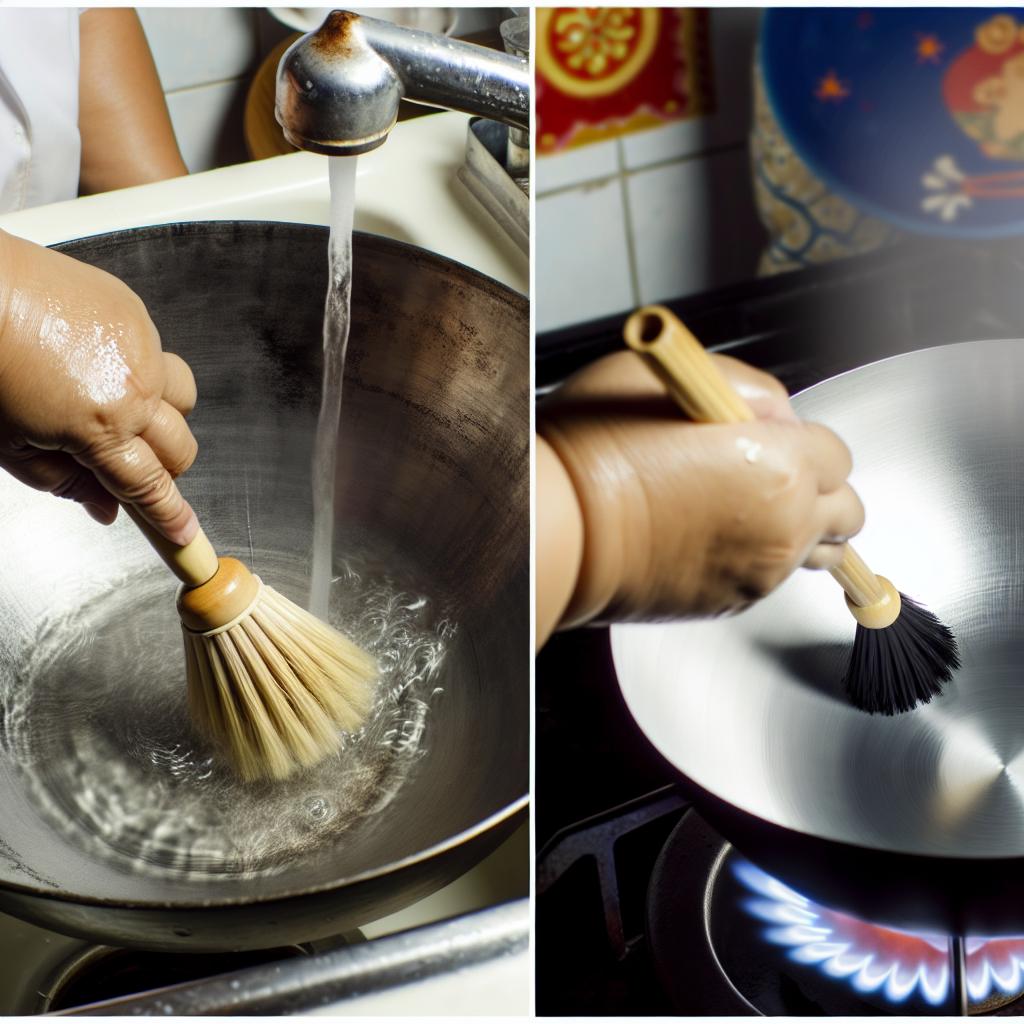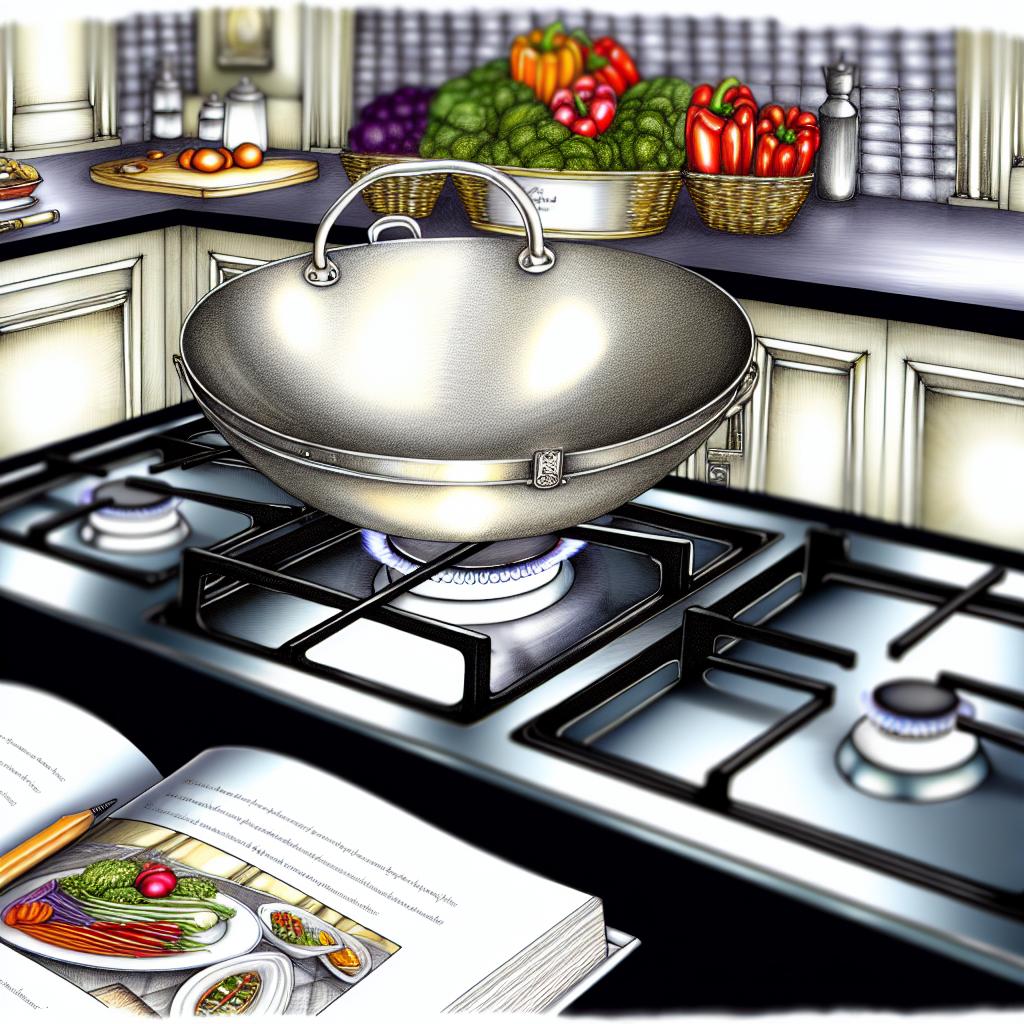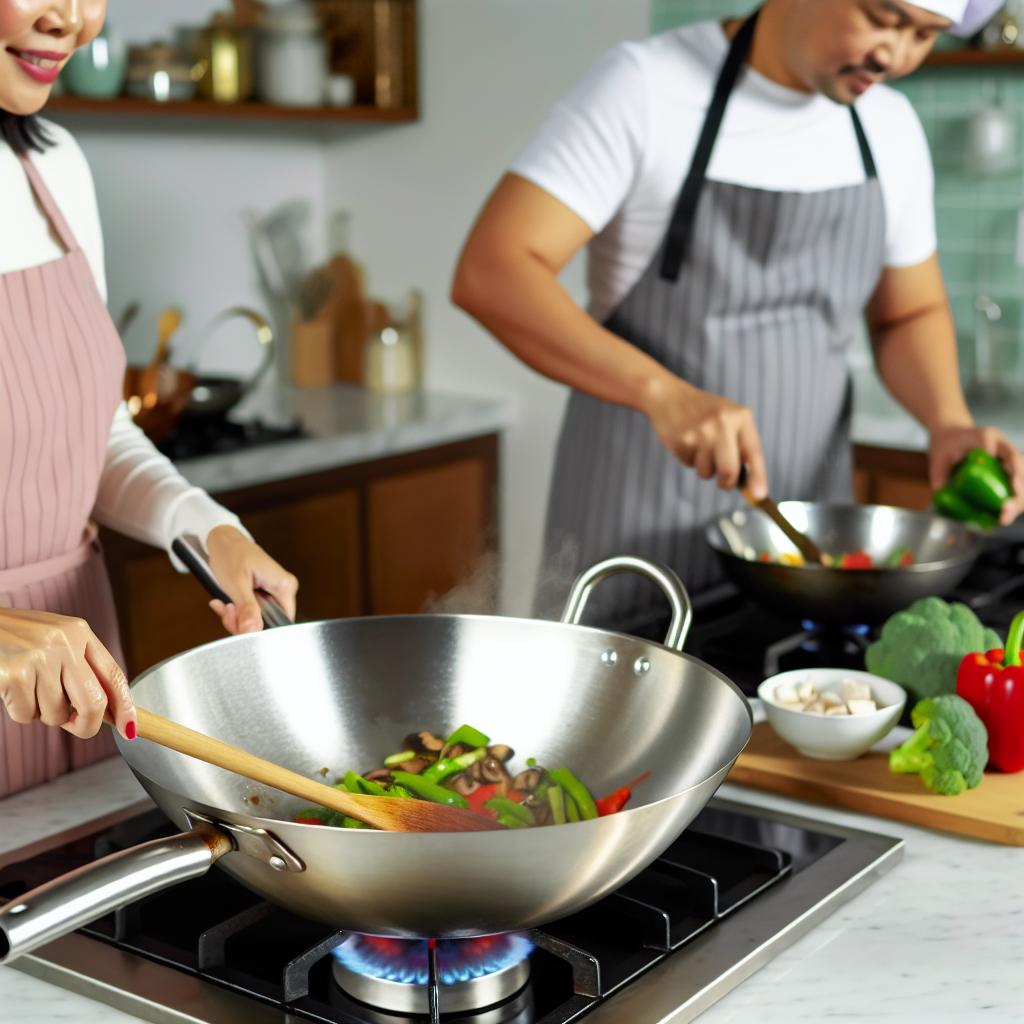Understanding Your Wok
When it comes to cooking, the wok stands out as an indispensable tool in many kitchens. Whether you’re stir-frying vegetables, searing meat, or even deep frying, the wok offers versatility and efficiency. However, to get the most out of your wok, understanding its material and maintenance needs is crucial. Among the most common materials, you’ll find woks made from carbon steel, stainless steel, or cast iron. Each of these materials necessitates specific care practices that can impact both the performance and longevity of your wok.
Initial Seasoning
Before using your new wok, a key step is to remove any protective coating that manufacturers often apply to prevent rust during shipping and storage. This is especially true for carbon steel and cast iron woks. The process of seasoning is crucial for these types and serves to enhance their non-stick properties. Here’s how you can go about it:
Cleaning: Begin by giving the wok a thorough scrub with warm water and a mild detergent. This step ensures that any factory-applied oils or coatings are completely removed.
Heating: Once cleaned, place the wok on a burner and heat it until it is entirely dry. This not only evaporates any residual moisture but also prepares the surface for the next step.
Oiling: Use a cloth or paper towel to apply a thin layer of high smoke point oil—such as vegetable or grapeseed oil—to the interior surface of the wok.
Heating Again: Return the wok to heat on medium-high until it begins to smoke. This heating should be repeated several times, allowing the oil to polymerize. This creates a protective layer that contributes to the wok’s non-stick performance over time.
Regular Use and Maintenance
Proper maintenance doesn’t stop at initial seasoning. Each type of wok material has its own protocol for cleaning and upkeep after every use to ensure that it remains in excellent condition for years to come.
Carbon Steel and Cast Iron Woks: These materials require a bit more attention. After using your wok, clean it with hot water and a sponge or soft scrub brush. Avoid soap unless absolutely necessary, as it can strip away the seasoning that you’ve worked to build. Ensure the wok is completely dry before storing it to prevent rust, applying a light coat of oil after drying will also help keep moisture at bay.
Stainless Steel Woks: More forgiving in nature, stainless steel woks can be cleaned with soapy water without the risk of degrading performance. Nonetheless, it’s advisable to dry them thoroughly before placing them in storage to guard against water spots and potential moisture-related issues.
Deep Cleaning
Even with regular cleaning, there will be times when your wok demands a deeper clean to tackle stubborn food residues or accumulated old oils. Here are the approaches tailored to each material:
– **Carbon Steel and Cast Iron Woks:** Elevate the wok on high heat until it’s very hot and then scrub the surface using coarse salt and a paper towel. This method helps break down and lift off difficult stains.
– **Stainless Steel Woks:** Create a mixture of vinegar and water to lift persistent stains gently. Alternatively, you can use a non-abrasive cleaner to achieve a similar effect without damaging the material.
Preventing Rust
For those using carbon steel and cast iron woks, rust prevention is a primary concern. It’s vital to store your wok in a dry location. If possible, hanging the wok can aid in promoting air circulation—which is beneficial in reducing moisture buildup. However, should rust form, fear not. Scrubbing the affected area with steel wool can remove the rust, after which you should re-season the wok to restore any lost protective qualities.
Storing Your Wok
When it comes time to store your wok, ensure it’s completely dry first. This simple step can prevent the trapping of moisture that could potentially lead to rusting or material degradation. For physical protection, hanging the wok is optimal, but if space is a constraint, stacking them with protective padding (such as felt or cloth pads) between each layer can prevent surface scratching and other forms of damage.
Conclusion
Taking proper care of your wok not only extends its working life but enhances its cooking performance, enabling you to achieve the desired results in every culinary endeavor. For an even deeper dive into wok care and mindful maintenance techniques, consider exploring comprehensive resources available on expert culinary websites or official cooking technique pages. These sources can offer a wealth of information that is specific to the material of your wok and support you in refining your cooking skills whilst preserving your kitchen equipment.
Introduction to Woks
The wok is an indispensable and versatile cooking tool, particularly prevalent in Asian cuisine. Its unique design, characterized by a wide base and high, sloping sides, lends itself to various cooking techniques that can significantly enhance the quality of home-cooked meals. This distinctive shape is ideal for quick cooking methods that preserve the texture and flavor of ingredients. In this article, we will explore the types of woks available, their distinguishing features, and considerations for selecting the perfect wok for your kitchen.
Types of Woks
Carbon Steel Woks: Carbon steel woks hold a prominent place in the hierarchy of wok types due to their excellent heat conduction capabilities and affordability, making them a preferred option for both novices and seasoned chefs. Over time, carbon steel woks develop a natural non-stick surface known as patina when they are properly seasoned. This surface is achieved through the repeated application of oil and heat, which must be meticulously maintained to ensure the wok remains rust-free. Attention to detail in drying and occasionally re-seasoning the wok ensures its longevity and reliability for various cooking methods.
Cast Iron Woks: Renowned for their impressive heat retention abilities, cast iron woks maintain consistent cooking temperatures, which can be particularly beneficial when cooking dishes that require steady heat. Though heavier than their carbon steel counterparts, cast iron woks are equally deserving of a place in the kitchen due to their robustness and durability. Similar to carbon steel, cast iron woks require regular seasoning and care to prevent rust and maintain their non-stick surface. Once properly maintained, they can serve you well for a lifetime, making them a sound investment.
Stainless Steel Woks: Stainless steel woks are celebrated for their durability and ease of cleaning. They offer a dazzling appearance and unwavering robustness; however, they do not match the heat conduction properties of carbon steel. To mitigate this shortfall, many stainless steel woks are often designed with aluminum or copper cores, enhancing heat distribution efficiency. This amalgamation ensures that despite the material’s inherent limitations, your cooking experience remains seamless and effective.
Features to Consider
Flat vs. Round Bottom: The choice between a flat and round-bottomed wok can have a considerable impact on your cooking experience. A flat-bottomed wok is tailored for modern stovetops, including induction and electric ranges. It offers stability and ensures even contact with the heat source, making it versatile for most home kitchens. Conversely, round-bottomed woks recreate traditional cooking dynamics when employed with a wok ring and gas burners. This choice delivers a more authentic cooking experience, particularly for those seeking to master traditional Asian cooking techniques.
Handles: Handles play a significant role in ensuring comfort and safety during cooking. The choice typically narrows down to woks with a single long handle or two small loop handles, each suited for different cooking styles. Long handles allow for agile maneuvering of the wok, facilitating techniques such as flipping and tossing, while loop handles provide a balanced hold, especially when stir-frying for larger gatherings. Regardless of the handle style, ensure they are comfortable and heat-resistant to add to your cooking convenience.
Size: Picking the right size for your wok is pivotal for meeting your culinary needs. A 12 to 14-inch wok stands as the most versatile option, accommodating a plethora of dishes and serving sizes, ideal for typical family meals. Yet, if you frequently cater to large groups, opting for a larger wok may be necessary to ensure all ingredients are cooked evenly without overcrowding.
Non-Stick Coatings
Non-stick woks offer incredible advantages in terms of ease of cleaning and minimizing the usage of oil, aligning with healthier cooking preferences. However, they come with their set of limitations. They do not withstand high temperatures as robustly as traditional materials like carbon steel or cast iron, which might influence their longevity and performance in high-heat applications. Additionally, the coating on non-stick woks is prone to damage from metal utensils, necessitating the use of silicone or wooden utensils to preserve their integrity.
Conclusion
Choosing the appropriate wok for your home cooking is primarily contingent upon aligning the wok’s features with your unique cooking needs and stove compatibility. Evaluating the materials, size, and design features carefully can guide you towards the most suitable wok that complements and elevates your culinary endeavors. For those keen on delving deeper into wok seasoning and maintenance techniques, resources from reputable cooking websites such as Serious Eats and Cooking Light offer extensive insights to ensure that your wok remains a trusted kitchen companion for years to come.
The Versatility of a Wok
The wok is a highly versatile cooking tool that originates from China and has become popular in various parts of the world. Due to its unique shape and features, it can be used for an array of cooking techniques beyond just stir-frying. The round-bottomed pan allows for even heat distribution, making it suitable for deep-frying, steaming, and even smoking foods. Additionally, its flared sides allow for comfortable stirring and tossing of ingredients.
Economical Cooking
Using a wok can be economical in terms of both time and energy. The high heat required for cooking with a wok means foods cook faster, which can save on electricity or gas. For more insight into energy-efficient cooking appliances, you can refer to this Energy Saver link. Additionally, the rapid cooking process not only allows for savings on energy costs but also means that meal preparation can be quicker, allowing for more efficient time management in the kitchen. This makes it especially beneficial for busy households or those who are looking to minimize their time spent cooking without compromising on the quality of meals.
Healthier Meal Preparation
The design of the wok is conducive to healthier cooking methods. Due to the small amount of oil required, as well as the rapid cooking process, nutrients in vegetables are better preserved compared to other cooking methods. Ingredients retain their color, texture, and vitamins, contributing to a nutritious diet. Moreover, the quick cooking technique allows ingredients to maintain their natural flavors, offering more taste with less need for additional seasonings or fats. The ability to cook a variety of meals in a wok, from steaming to frying, all while maintaining the inherent nutritional value of the ingredients, showcases its effectiveness as a tool for healthier cooking.
Durability and Longevity
Woks are generally made from materials such as carbon steel or cast iron, which are known for their durability. They could last for many years if properly maintained. Carbon steel woks, for instance, require seasoning, an essential process that creates a natural non-stick layer, enhancing both the flavor and longevity of the cooking surface. Proper care, including routine cleaning and re-seasoning, can ensure the wok remains in optimal condition over time. Additionally, the initial investment in a high-quality wok can lead to long-term savings by eliminating the need for frequent replacement kitchenware items. This durability makes woks not just essential for their cooking capabilities, but also economical in terms of long-term kitchen investments.
Enhancing Flavors Through Seasoning
The unique ability of a wok to be seasoned allows it to build flavor over time. As a wok is used, it becomes naturally non-stick and accumulates a layer known as the “patina.” This enhances the flavor of subsequent dishes cooked in the wok. Seasoning your wok properly ensures an optimum cooking experience each time, and more information on this process can be found in specialized culinary guides or reputable cooking sites. Additionally, as the wok is repeatedly seasoned and used over time, the patina develops a unique flavor profile that can add depth to various dishes that are prepared in it, giving each meal a distinctive taste that goes beyond standard cooking methods.
The capability of a wok to be multi-functional extends its usability across different culinary traditions and cooking styles. Beyond traditional Chinese dishes, the versatility of the wok makes it an ideal tool for Western cuisines as well, allowing chefs and home cooks alike to explore a range of recipes.
In conclusion, cooking with a wok offers numerous benefits, from versatility and cost-effectiveness to healthier food preparation and long-term kitchen value. Investing in a good quality wok can significantly enhance your cooking repertoire, while also making meal preparation more enjoyable and efficient. One key advantage is the ability to use a single tool for a variety of cooking methods, thereby minimizing the need for multiple cookware items, simplifying kitchen organization, and streamlining cooking processes.
The wok’s design, which facilitates fast, even cooking and easy handling, complements different dietary needs and preferences, allowing for the preparation of both simple and complex dishes. Whether you are deep-frying, stir-frying, or smoking, the wok’s construction is such that it adapts well to each cooking style. Furthermore, the health benefits associated with using a wok, from nutrient retention to reduced oil necessity, align well with modern culinary trends that emphasize nutritious, balanced meals.
Although more prevalent globally now, the wok’s origins are steeped in rich culinary traditions, paying homage to the ancestry of Asian cooking techniques, which underline the fusion of flavors and techniques. The incorporation of a wok into your cooking routine not only broadens the spectrum of dishes that can be prepared but also supports a culinary journey that respects and reinvents traditional cooking methods.
Overall, the advantages of utilizing a wok in both personal and professional kitchens speak to its durable design and ability to consistently deliver delicious, healthy, and efficient meals. It is a testament to the blending of form and function, a timeless tool that, when appropriately employed and maintained, will remain an invaluable asset to cooks everywhere.


